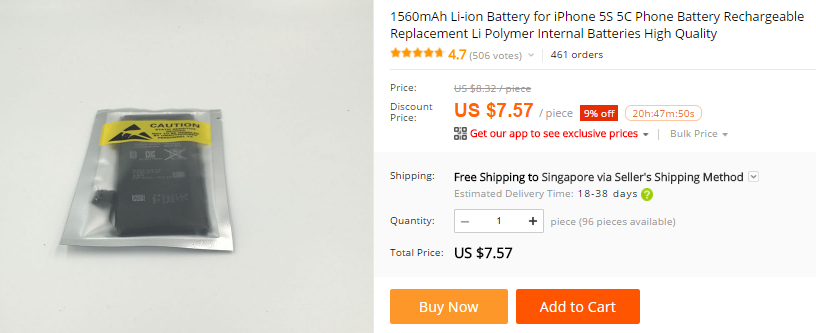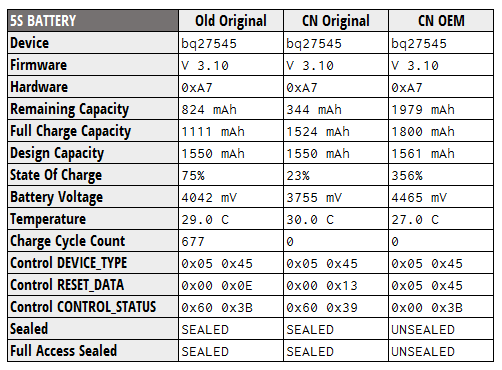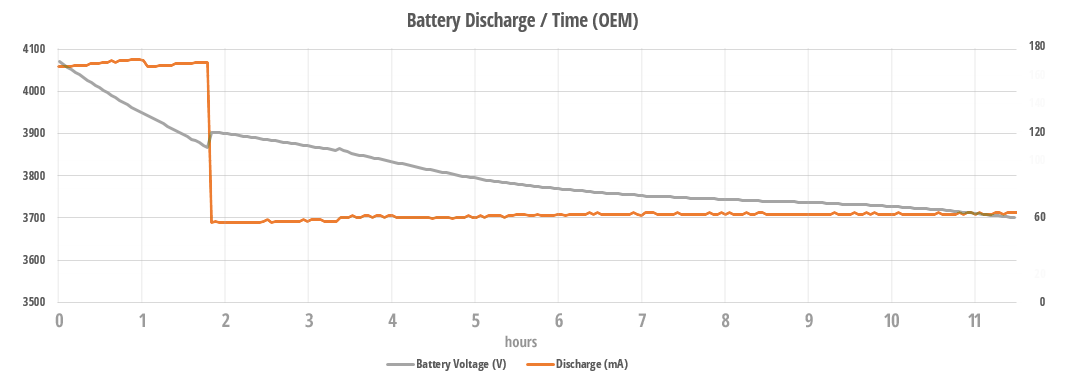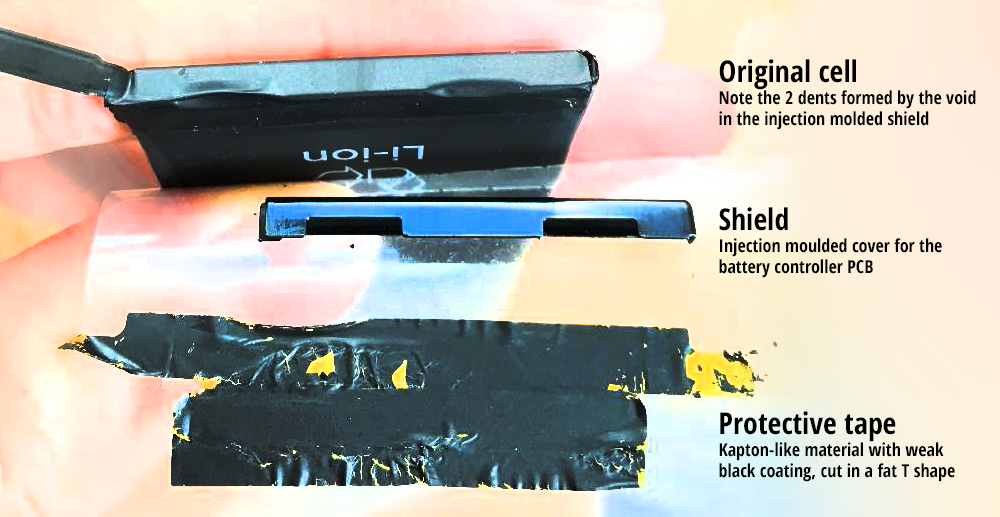Identifying and buying a good iPhone battery from China
Sat, May 13, 2017
Purchasing a replacement battery for an iPhone (5S) from typical Chinese sources yield fantastic prices, but they rarely match up with their advertised capacity.
What’s in an iPhone battery?

Above: What sellers describe as an “OEM” battery. I’ve removed the tape off the battery controller. It is difficult to discern between this and the “Apple Original” battery.
The 2 significant parts of an iPhone battery are:
Lithium Polymer battery (“1S1P”). The remaining capacity of the battery can be approximated by its voltage, at ~3.7V flat, and ~4.2V full. The iPhone 5S has a 1560mAh battery.
The charge controller. This tiny board contains circuitry to protect the board from over-temperature, over-charge and over-discharge, and also reports the battery’s vitals such as its charge state. The 5S board contains the Texas Instrument’s bq27545 and the proprietary flex cable, and is spot welded on the battery’s terminals.
After tearing down some batteries, I gathered that the iPhone batteries on sale are a permutation of:
Lithium Polymer Battery
“Apple Original”: The most expensive and rarest - new ones are acquired from factories or other unusual means. These are as good as the ones as you would get from a new iPhone.
“OEM”: (Shown in earlier picture) More common, where third party battery manufacturers attempt to clone an “Apple Original” with all the markings and colors of the original, usually with less capacity than described.
Generic: Also common, where third party battery manufacturers build a compatible battery but abandon all pretence of appearing as the original. They come with their own branding and sometimes even with “more” capacity.
Charge Controller
“Apple Original”: The original board with the bq27545. Could be from a factory or salvaged from a dead battery.
“OEM” Old: Reports itself as an iPhone 4 charge controller. Does not appear to be in production anymore. Very well documented by Jason’s Rip It Apart blog
“OEM” New: (Shown in earlier picture) Reports itself as a 5S charge controller and works similarly, but with some quirks described later.
The deceptive bits: The OEM battery (controller) will always appear healthy
Often, buyer feedback on online retailers will tout satisfactory screenshots of their new battery’s health via various battery apps. Unfortunately this is one of the easiest way to be deceived.
The iPhone mainboard itself does not measure the battery in any way. Instead, it trusts the controller to report everything about the battery. Normally, the bq27545 obediently reports these information to the iPhone via the HDQ wire.

By using an Arduino UNO and modifying mozzwald’s code, it is possible to read the battery’s HDQ reports as an iPhone would receive it. Above, I have compared an old 5S battery along 2 purchases from China: an “Apple Original” and an “OEM”.
The “OEM” controller has some subtle differences - the capacity values are inconsistent and the battery is not locked (“unsealed”). Additionally, the response registers are not updated when querying for RESET_DATA, instead returning the data for the previous query, DEVICE_TYPE. This implies that it observes the TI HDQ protocol but does not fully implement all its features.
There is a strong likelihood that it can be configured to mis-report the battery’s capabilities, thus the OEM battery’s reported mAh on the iPhone cannot be trusted.
How much charge can the OEM battery really hold?

This is a unscientific test, but it should provide a good gauge of the charge capacity.
I charged an OEM battery with the TP4056 (Li-Po charger, fixed max voltage at 4.2V) and discharged it with an adjustable load. The cell stopped charging at 4.1V and test was set to end when the battery reaches 3.7V or if it could no longer provide the required current.
The load current was initially set at ~160mA. As the voltage was sagging under load, I reduced the load to ~60mA at about the 2 hour mark.
Result: 650mAh. Should it be possible to charge to 4.2V, it could probably provide about 800mAh, half the capacity of a genuine iPhone cell.
And the “Apple Original”?
1566mAh. My 5S with that battery is configured for only cellular services (no data), and could hold more than 8 days of charge.
Verifying “Apple Original” - Slightly destructive, more accurate

While there is no clear cut way to identify a cell produced by Apple, it is easier to identify a genuine controller by finding the 3 golden test points in the center of the board, on the battery tabbing side. The protective tape has to be removed, and it is difficult to replace the tape.
From there, it may be possible to check if the battery has been re-tabbed, and subsequently infer if the cell is genuine.
Verifying “Apple Original” - Non-destructive

Lightly press on the edges of the battery on the flex-cable end. 2 distinct dents should form as part of the protective shield’s design.
Takeaway: Which should I buy?
If you can find it, the “Apple Original” ones are without doubt, the best. They are sometimes described as “AAA” grade.
A good “OEM” cell that is re-tabbed onto the original bq27545 is a next best alternative (“AA”).
Generic cells come across as the dodgiest and I would recommend avoiding them whenever possible.
It is difficult to grade Chinese products in a binary “fake or real”. it is more of a scale of “how much quality one will pay for”, and with some diligence, it is possible to find a satisfactory product!
Tips (uncategorized):
Be wary of “charge cycle count”, even on the genuine bq27545 - as the (full) unseal key may already be available. This allows direct access to the chip’s memory to reset the charge cycle count.
After re-tabbing a battery, the controller will be deactivated and can be reawakened by connecting power to VBAT and GND (or just charging it).
Ethics: I do not have any vested interest in iPhone batteries. I just like to know what I’m really purchasing :^)
My remaining ~6 new cells will be integrated in portable devices - even at 800mAh, the form factor is still very energy-dense, and comes with a gas gauge!